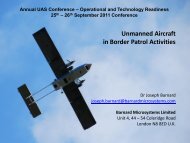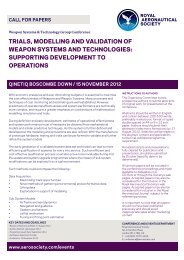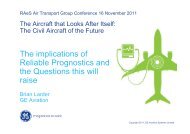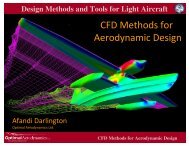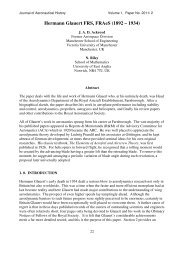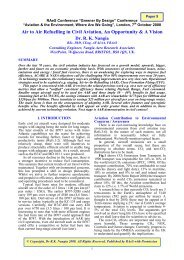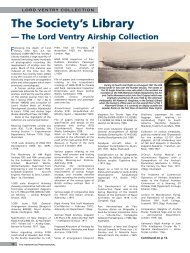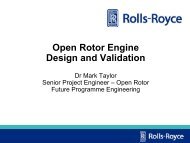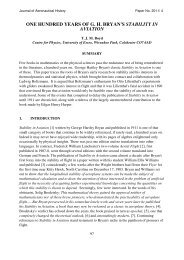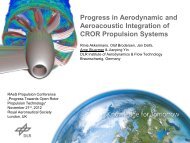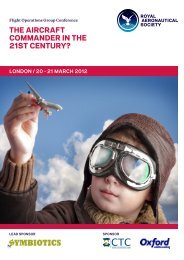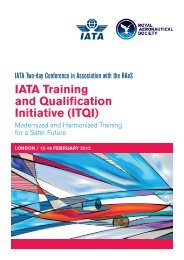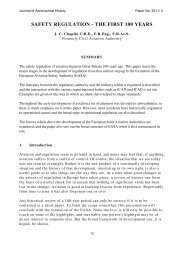Flight Control System Design Challenges
Flight Control System Design Challenges
Flight Control System Design Challenges
You also want an ePaper? Increase the reach of your titles
YUMPU automatically turns print PDFs into web optimized ePapers that Google loves.
<strong>Flight</strong> <strong>Control</strong> <strong>System</strong><br />
<strong>Design</strong> <strong>Challenges</strong><br />
Dr Matt Bennett<br />
SkyCircuits Ltd
<strong>Flight</strong> <strong>Control</strong> <strong>System</strong><br />
Radio-<strong>Control</strong>led (RC) Aircraft<br />
Servos<br />
RX
<strong>Flight</strong> <strong>Control</strong> <strong>System</strong><br />
Unmanned Aircraft with Autopilot<br />
Pitot GPS<br />
Servos AP<br />
RX
Autopilot<br />
Will have control for most (if not all) the flight<br />
Must be accurate, reliable, integrate with airframe,<br />
do what the operator(s) ask<br />
<strong>Challenges</strong> grouped into:<br />
Algorithmic<br />
Hardware<br />
User-Interface
<strong>Challenges</strong>:<br />
Algorithmic
Algorithmic: Orientation<br />
Avoid “Gimbal-Lock”
Algorithmic: Orientation<br />
Avoid “Gimbal-Lock”<br />
Change of heading or bank?
Algorithmic: Orientation<br />
Avoid “Gimbal-Lock”<br />
Uses quaternion representation for internal<br />
calculations<br />
Solves gimbal-lock problem<br />
More computationally intensive<br />
Still need to translate two/from Euler angles for<br />
humans
Algorithmic: Orientation<br />
No direct measurement of orientation<br />
Approximate with gravity (accelerometer) and Earth’s magnetic<br />
field (magnetometer)<br />
Use gyroscopes to measure angular rates<br />
Use extended Kalman filter to fuse sensor information into most<br />
likely orientation estimate<br />
Computationally intensive<br />
Needs a lot of memory<br />
Develop custom code<br />
ANGLES<br />
ACC<br />
EKF<br />
MAG<br />
GYRO
Algorithmic: Position<br />
GPS main source of position<br />
Signal cannot be guaranteed<br />
Relatively slow update rate<br />
Incorporate “dead-reckoning”<br />
Project current ground speed and heading<br />
Use accelerometers for inertial movement
Algorithmic: <strong>Control</strong>lers<br />
PID controllers widely used<br />
Simple, but requires correct gain values<br />
Humans needed to tune gains<br />
More of an art than a science<br />
Gains may need tuning for each airframe<br />
Smooth switch manual to auto<br />
Handle control surface saturation
Algorithmic:<br />
<strong>Control</strong>ler Architecture<br />
Different types of controller architecture<br />
Altitude by throttle, or altitude by elevation angle?<br />
Depends on airframe<br />
Traditional fixed-wing, flying-wing<br />
Multirotor, airships<br />
Can change in-flight (cruise, landing)<br />
Needs dynamic architecture, programming challenge
<strong>Challenges</strong>:<br />
Hardware
Hardware: Size & Cost<br />
Smaller autopilot unit<br />
Fits into more airframes, more<br />
room for payload, weighs less<br />
Need small, low-cost sensors<br />
Smartphone/gaming technology<br />
Not as accurate<br />
Bias changes, resolution, noise
Hardware: Low-Power<br />
Both electrically (good) and processing ability<br />
(bad)<br />
Limited processing power<br />
More optimisation needed for algorithms<br />
Unable to perform image analysis etc.
Hardware: Robust<br />
Case style (weight vs size and protection)<br />
Accept a wide range of input voltages<br />
Good quality connectors<br />
Reliable radio-frequency communications<br />
Long range OR high bandwidth<br />
Fault detection<br />
Redundancy
Hardware: Extension<br />
Many customers want additional hardware<br />
SD card loggers, ADC, interface with onboard PC<br />
Rather than make a larger, more complex autopilot with<br />
features not all customers need<br />
Keep autopilot hardware for flight only<br />
Have a payload extension port that allows additional<br />
modules to be attached
<strong>Challenges</strong>:<br />
User-Interface (UI)
UI: Requirements<br />
Contradictory requirements?<br />
Flexible, broad range of autopilot commands to<br />
allow wide range of missions<br />
Simple, easy-to-use interface for non-technical<br />
users<br />
One solution: split into specialised applications
UI: Simple & Advanced<br />
Simple (typical user)<br />
Split further into different mission phases:<br />
Plan<br />
<strong>Flight</strong><br />
Advanced (UAS manufacturer, advanced users)<br />
“Swiss-army knife” of full autopilot commands and<br />
configuration settings<br />
Ability to set safe user defaults
UI: Plan
UI: <strong>Flight</strong>
UI: GCS
UI: Advanced<br />
For complex and dynamic missions, the GCS<br />
operator cannot be expected to send each command<br />
themselves<br />
Implement a scripting language<br />
Auto-generate script for simple plans<br />
Allow advanced users to create own scripts<br />
Script language needs to be compromise between<br />
ease of use and complexity / memory usage
Summary<br />
Autopilot key to <strong>Flight</strong> <strong>Control</strong> <strong>System</strong><br />
Algorithmic challenges<br />
Orientation, position, control<br />
Hardware challenges<br />
Size, cost, power, robust, reliable, extendable<br />
User interface challenges<br />
Powerful, configurable, clear, easy to use, different types<br />
of user



